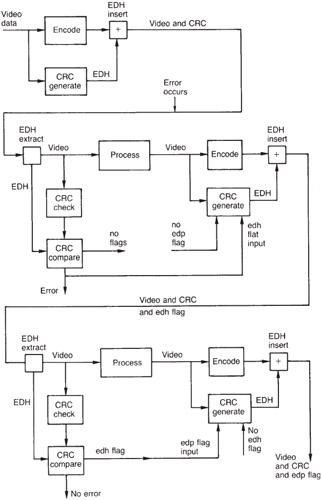7.14 EDH -- Error Detection and Handling
| | ||
| | ||
| | ||
7.14 EDH Error Detection and Handling
Surprisingly, the original SD-SDI standard had no provisions for data integrity checking. EDH is an option for SD-SDI which rectifies the omission 13 , 14 . Figure 7.47 shows an EDH equipped SDI (serial digital interface) transmission system. At the first transmitter, the data from one field is transmitted and simultaneously fed to a cyclic redundancy check (CRC) generator. The CRC calculation is a mathematical division by a polynomial and the result is the remainder. The remainder is transmitted in a special ancillary data packet sent early during the vertical interval, before any switching takes place in a router 14 . The first receiver has an identical CRC generator that performs a calculation on the received field. The ancillary data extractor identifies the EDH packet and demultiplexes it from the main data stream. The remainder from the ancillary packet is then compared with the locally calculated remainder. If the transmission is error free, the two values will be identical. In this case no further action results. However, if as little as one bit is in error in the data, the remainders will not match. The remainder is a 16-bit word and guarantees to detect up to 16 bits in error anywhere in the field. Greater numbers of errors are not guaranteed to be detected, but this is of little consequence as enough fields in error will be detected to indicate that there is a problem.

Figure 7.47: A typical EDH system illustrating the way errors are detected and flagged. See text for details.
Should a CRC mismatch indicate an error in this way, two things happen. First, an optically isolated output connector on the receiving equipment will present a low impedance for a period of 1 to 2 milliseconds . This will result in a pulse in an externally powered circuit to indicate that a field contained an error. An external error-monitoring system wired to this connector can note the occurrence in a log or sound an alarm or whatever it is programmed to do. As the data have been incorrectly received, the fact must also be conveyed to subsequent equipment. It is not permissible to pass on a mismatched remainder. The centre unit in Figure 7.47 must pass on the data as received, complete with errors, but it must calculate a new CRC that matches the erroneous data. When received by the third unit in Figure 7.47, there will then only be a CRC mismatch if the transmission between the second and third devices is in error. This is correct as the job of the CRC is only to locate faulty hardware and clearly if the second link is not faulty the CRC comparison should not fail. However, the third device still needs to know that there is a problem with the data, and this is the job of the error flags that also reside in the EDH packet. One of these flags is called edh (error detected here) and will be asserted by the centre device in Figure 7.47. The last device in Figure 7.47 will receive edh and transmit eda (error detected already). There are also flags to handle hardware failures (e.g. overtemperature or diagnostic failure). The idh (internal error detected here) and ida (internal error detected already) handle this function. Locally detected hardware errors drive the error output socket to a low impedance state constantly to distinguish from the pulsing of a CRC mismatch.
A slight extra complexity is that error checking can be performed in two separate ways. One CRC is calculated for the active picture only, and another is calculated for the full field. Both are included in the EDH packet shown in Figure 7.48. The advantage of this arrangement is that whilst regular programme material is being passed in active picture, test patterns can be sent in vertical blanking which can be monitored separately. Thus if active picture is received without error but full field gives an error, the error must be outside the picture. It is then possible to send, for example, pathological test patterns during the vertical interval to stress the transmission system more than regular data to check the performance margin of the system. This can be done alongside the picture information without causing any problems.

Figure 7.48: The contents of the EDH packet which is inserted in ancillary data space after the associated field.
In a large system, if every SDI link is equipped with EDH, it is possible for automatic error location to be performed. Each EDH-equipped receiver is connected to a monitoring system that can graphically display on a map of the system the location of any transmission errors. If a suitable logging system is used, it is not necessary for the display to be in the same place as the equipment. In the event of an error condition, the logging system can communicate with the display by dialup modem or dedicated line over any distance. Logging allows infrequent errors to be counted. Any increase in error rate indicates a potential failure that can be rectified before it becomes serious.
An increasing amount of new equipment is available with EDH circuitry . However, older equipment can still be incorporated into EDH systems by connecting it in series with proprietary EDH insertion and checking modules.
| | ||
| | ||
| | ||
EAN: 2147483647
Pages: 120